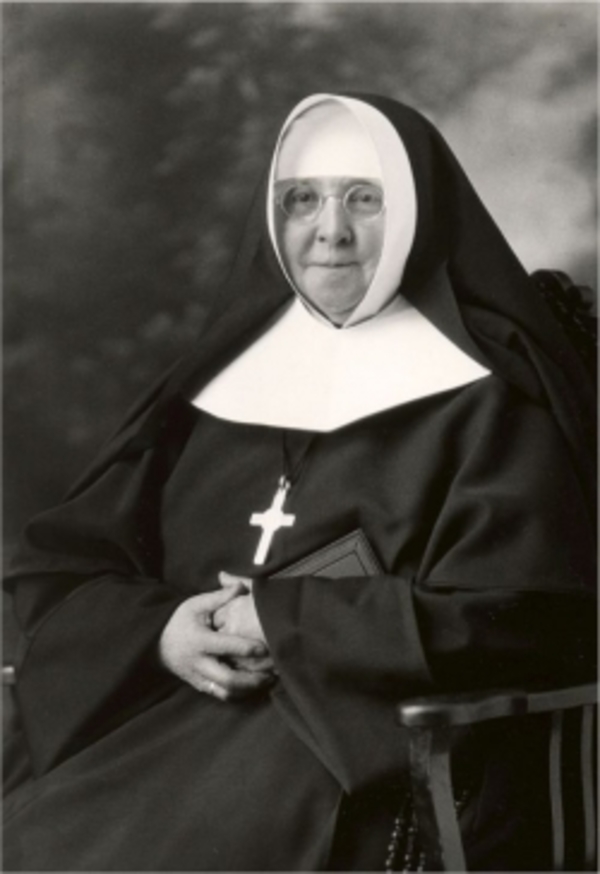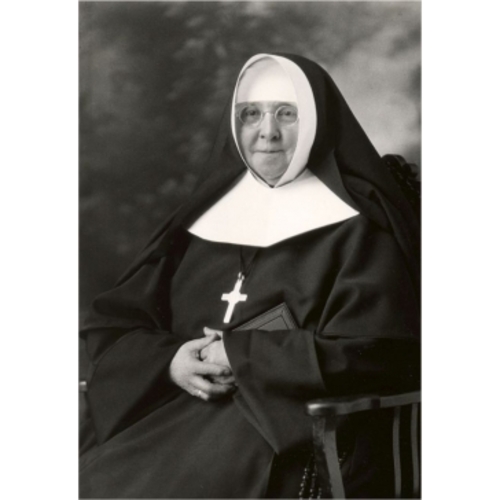
Source: Link
BERGERON, Élisabeth (baptized Elizabeth), named Saint-Joseph, founder of the Sœurs de Saint-Joseph de Saint-Hyacinthe; b. 25 May 1851 in Saint-Hyacinthe (La Présentation), Lower Canada, daughter of Théophile Bergeron, a farmer, and Basiliste Petit; d. 29 April 1936 in Saint-Hyacinthe.
Élisabeth Bergeron was the fourth in a family of 11 children and from the time she was a child she stood out because of her interest in the Christian rituals that marked the family and parish life of the period. She attended the rural school in La Présentation for a few years and learned to read there. Like many children of her time, however, she did not learn to write. Her piety and attentiveness to catechism led the parish priest to allow her to take her first communion at the age of eight. At 14, she applied in vain for admission to the Sœurs de la Charité de Saint-Hyacinthe. For economic reasons, her family lived in New England from 1865 to 1870, first for a year in Brunswick, Maine, and then in Salem, Mass. With the other members of her family, Élisabeth worked in a mill which likely caused her frequent illnesses. She also taught catechism to the children in the area who were deprived of religious instruction. Back in La Présentation, she was admitted in March 1871 to the Sisters Adorers of the Precious Blood, a local contemplative congregation founded by Aurélie Caouette* in 1861. But in July she had to leave on the advice of the founder, who judged that, given the strictness of the rules, she did not have the vocation of an adorer. The same year she made another vain attempt, this time with the Sisters of Miséricorde in Montreal; she left of her own accord after a few days as a postulant. In 1876 she was refused by the Sisters of the Presentation of Mary because of her lack of education, and she became a member of the Dominican third order.
Élisabeth continued to lead a life of devotion and on the recommendation of her spiritual director even asked, twice, the bishop of her diocese, Louis-Zéphirin Moreau*, for permission to found a Dominican contemplative congregation. He suggested that she found a teaching congregation instead. Being unable to write, she argued that she lacked education, but the bishop urged her to find companions who were better educated, and the fledgling Sœurs de Saint-Joseph de Saint-Hyacinthe was established in the village of La Providence (Saint-Hyacinthe) in 1877, with four nuns receiving pupils as of 17 September. On 17 Aug. 1878 Élisabeth took the name of Sister Saint-Joseph. The first years, marked by poverty, death, and the illness or departure of several candidates, were difficult. The little team survived thanks to donations from neighbouring congregations, but drew criticism from all levels of the diocesan hierarchy: according to the annals of the congregation, they were called “insane and fanatic old maids.” Nevertheless, the bishop stood firm because, through this initiative, his diocese benefited from a teaching congregation that was under his sole authority, unlike the Sisters of the Presentation of Mary, who had been in the diocese since 1853 but had their mother house in France. His aim was to endow small parishes with teaching nuns devoted to instructing both girls and boys in model and elementary schools. He went even further, writing in his foundation rules of 19 March 1882: “It is our express wish that they never run a boarding school for young people, in order that they not be diverted in any way from the primary goal of their establishment, which We wish absolutely to preserve just as We have always envisioned it.” Thus restricted, the new congregation would be unable to compete with the older orders that had more prestigious institutions.
The founder was often ill and, evidently, neither sufficiently educated nor sufficiently competent to run this fledgling endeavour. In 1879 Bishop Moreau decided, without consulting anyone, to strip her of her authority as mother superior. In her place he appointed the first postulant of the congregation, Mother du Précieux-Sang, a 20-year-old novice! It was therefore in her capacity as founding mother, a title she would hold for the rest of her life, that Mother Saint-Joseph took her perpetual vows on 19 March 1880.
In 1886 the bishop endowed the congregation with a general governing board to which Mother Saint-Joseph would be regularly elected as adviser or assistant until 1925. It might be surmised that although she had official duties, she played only a secondary role in managing her community, which was really Moreau’s. Until his death in 1901, he made all the important decisions: the move to Saint-Hyacinthe in 1881, the construction of the mother house (where the nuns settled in 1889), the creation of the juniorate in 1893, the foundation of schools, the writing of the first version of the customary (the congregation’s rules), the ban on Holy Year indulgences, and the expansion beyond the diocese. Venerated within the congregation for her humility (she slept in the dormitory with the sisters), her faith in St Joseph, and her piety, Mother Saint-Joseph visited each of the new houses with the mother superior as they were established. In 1911 she even travelled to the Canadian west to the missions of Lorette (Taché), Man., and Marieval, Sask., both instituted in 1901. In Quebec the community extended its reach to the parishes of the diocese of Saint-Hyacinthe where a school was opened approximately every two years. Meanwhile, Mother Saint-Joseph busied herself with gardening and sewing. She was no entrepreneur: she was a founder who worked in the background, but people regularly sought her advice.
At the death of Mother Saint-Joseph on 29 April 1936, which was followed by a spectacular funeral, the congregation was responsible for 39 schools in Quebec, 5 in Manitoba, 2 in Saskatchewan, 1 in Ontario, and 1 in New Hampshire. Nearly 550 young girls had taken their vows in this congregation dedicated to teaching and humility, which did not set up a school for post-primary students until 1941, and did not itself obtain final papal approval until 1962.
The contradictions of Mother Saint-Joseph’s career no doubt contributed less than her virtues to the decision to introduce the cause for her beatification in Rome in 1976. She was declared venerable on 12 Jan. 1996.
The author consulted 15 letters dictated by Mother Saint-Joseph between the years 1930 and 1935, as well as the annals and chronicles of the congregation, in the Arch. des Sœurs de Saint-Joseph de Saint-Hyacinthe in Quebec.
BANQ-CAM, CE602-S3, 25 mai 1851. Le Devoir, 30 avril 1936. La Presse, 30 avril 1936. André Guay, Dieu choisit les humbles: Élisabeth Bergeron (1851–1936) (Saint-Hyacinthe, 1977). Yvon Langlois, Élisabeth, parfum d’étoile ([Montréal, 1998]). Angelo Mitri, Vie et vertus de mère Saint-Joseph, Élisabeth Bergeron, fondatrice de la congrégation des Sœurs de Saint-Joseph de Saint-Hyacinthe, 1851–1936 ([Saint-Hyacinthe, 1972?]). Sœur Sainte-Marie-Bernard [Alice Bourassa], Mère Saint-Joseph, fondatrice de l’institut des Sœurs de Saint-Joseph de Saint-Hyacinthe, 1851–1936 (Saint-Hyacinthe, 1949). Sœurs de Saint-Joseph de Saint-Hyacinthe, Au cœur du projet de Dieu, 1877–1977 ([Saint-Hyacinthe, 1977?]).
Cite This Article
Micheline Dumont, “BERGERON, ÉLISABETH (baptized Elizabeth), named Saint-Joseph,” in Dictionary of Canadian Biography, vol. 16, University of Toronto/Université Laval, 2003–, accessed January 17, 2026, https://www.biographi.ca/en/bio/bergeron_elisabeth_16E.html.
The citation above shows the format for footnotes and endnotes according to the Chicago manual of style (16th edition). Information to be used in other citation formats:
| Permalink: | https://www.biographi.ca/en/bio/bergeron_elisabeth_16E.html |
| Author of Article: | Micheline Dumont |
| Title of Article: | BERGERON, ÉLISABETH (baptized Elizabeth), named Saint-Joseph |
| Publication Name: | Dictionary of Canadian Biography, vol. 16 |
| Publisher: | University of Toronto/Université Laval |
| Year of publication: | 2016 |
| Year of revision: | 2016 |
| Access Date: | January 17, 2026 |



